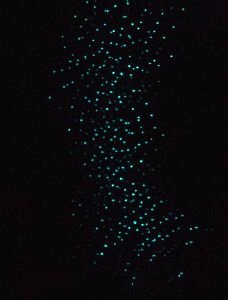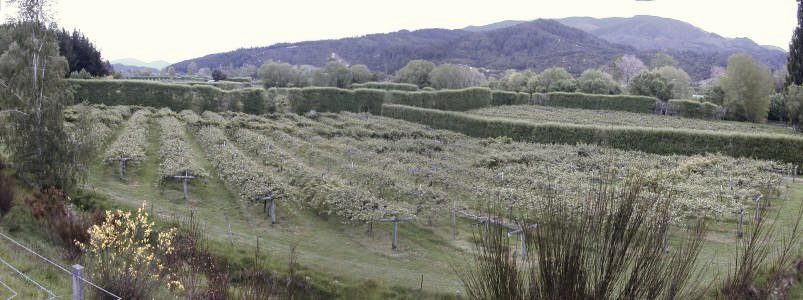Our group of four plus a guide set out while another similar group was getting organized.
We took a side trip up one of the streams that emerge from the forest.
The guys in the other kayak decided it was time for a swim. Actually the decision was made for them by the cross currents.
We watched these folks watching us from a suspension bridge upstream.
At lunch the other group caught up with us and their guide gave a lesson in Maori warcraft/battle technique.
The picnic blanket later served as an sail with our paddles serving as makeshift but effective masts and rudder.
We then all joined in a hike up a trail where we learned about the birds, animals, foods, medicines and materials that the forest provides.
Some seals and cormorants on the rocks on some of the islands we passed.
t
Our crew all survived the trip and were ready to tackle any invaders that we may happen upon.
Later in our visit we toured a very wet cave.
We wore bathing suits, two pairs of long johns, farmer john wetsuit with a wetsuit jacket over that, double layer of wool socks, and heavy boots.
In addition we had a rubber hood and hard hat to protect our head and for most of the trip we wore neoprene gloves.
The hike in and back out was strenuous with all those layers.
.
Trail
to the
cave from avk43
on Vimeo.Every bit of that protection was needed for the trip through the cave
One of the highlights was floating on inner tubes in total darkness except for the light of glowworms that covered the ceiling.

Another part of the adventure was a slide down a natural stream bed into a pool at the bottom.
Slide 84 from avk43 on Vimeo.
Very fast and quite bumpy.
At the end of the trip we were served refreshments while we soaked in a hot tub.
I got used to driving on the other side of the road ... mostly.
We have some one lane bridges in Kentucky but apparently in NZ they are shared with trains as well.
Who has the right of way is clearly marked.
A red circle and big black down arrow says yield. A blue rectangle and red up arrow says you can go.
We never met a train but no matter what the sign said I would have yielded.
Lots of hedges, these protecting kiwi vines and just open fields.

A panorama of a glacier fed lake.
It really was the color you see in the picture, I haven't manipulated the colors.

Some other sights from our travels.
Some random unplanned stops along the way included a mountain top observatory.
A craft fair where Nancy chatted with the vendors and picked up some NZ wool slippers as souvenirs.
We found another hot spring.
This one a lot clearer than the ones we had visited on the north island.
Sea shore sights.
We noticed this rock on the beach.
We have no idea who had written it or why.
This lone seal was defending its spot on the beach.
We saw immense tree farms and this timber ready to be shipped out.
Roads were not all what we expected.
Some were carved out of the sides of mountains.
Others went under bridges that rock slides would pass over.
This one was being repaired because the mountain had collapsed under one of its supports.
The road signs are nothing if not explicit.
We saw this group on their way to Mt. Cook.
We learned some of the Maori customs, songs and games at a cultural center.
During a night hike we saw kiwi's in the wild but weren't permitted to take pictures of them there so this indication that they frequent the area will have to do.
These two dark pictures were taken using only the very little light that they tolerate in a facility where captive birds are raised for release to the wild.
The next two pictures were taken by a wildlife specialist as part of a study.
We could study details of this mounted specimen.
And we finally found this recipe to properly prepare a kiwi.
Other birds we saw on our travels.
The cormorants were on a stony bar just off the coast.
Nancy discovered the quail on a trail we happened upon. It scurried into the brush while she was stalking it but she did get this great shot.
The Cape Barren Goose was on another trail. It was obviously very used to tourists.
The pukeko was in one of our camp areas.
The black swan and kea were in the Maori cultural center.
We discovered this nest near the Mt. Cook visitors center.
I went fossicking and found a gold flake in this stream near where gold had been mined.
The museum had models of the area and machinery that was used to extract the gold.
The trail outside led past some of the abandoned equipment, like this water canon used to wash gold carrying gravel from the hillside.
We stopped at the Franz Joseph Glacier but decide to hike on the Fox Glacier which is a little further south.
The trail leading to the face of the glacier is not without hazards.
We were told that rocks the size of houses occasionally roll across it.
Swimming here is discouraged.
Even walking down to the edge can get you into a lot of trouble if you happen to be there when the ice shelf hanging over the water collapses and throws up a wave that will likely wash you away.
The trail, loosely defined, to the top of the glacier.
We looked back at the valley the glacier had carved.
You can see we have climbed quite a way above our starting point.
Look closely and you can see dots that are people on the trail to the glacier face.
Turning toward the glacier we could see just what we had in store.
In the center of the second picture you may be able to make out some people.
That is where we are going.
When we got to the glacier itself we donned instep crampons for surer footing on the ice.
Some places the guides had installed ice anchors and climbing ropes for an additional level of safety.
The guide was helpful and was ready to talk about anything from the local geology to world politics.
We were fortunate to find an ice cave that was safe to enter.
We pointed out a rock over our trail that seemed about ready to fall.
Our guide said he thought it was secure but climbed up to test it with his ice ax.
It came tumbling down with little effort on his part.
A room size rock, a hole where a stream of water disappeared, and crags and crevices.
Some views of the valley from out on the glacier.
A couple of shots from Christchurch.
We stopped at the Antarctic Centre where we went into a room that simulated the incredibly cold and windy environment there.
Fossils collected in Antarctica indicate that it was once much warmer.
Penguins were being fed and we learned about some of the many different ones from around the world.
At the time of our visit we had not yet planned our trip to Antarctica that we took only a couple of months later.
Click here to see some pictures from that trip.